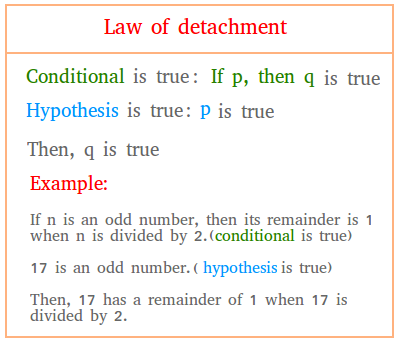Law of detachment
Below see the law of detachment and some concrete examples to illustrate the law.
A real life example of the law of detachment
No one needs to be a rocket scientist to know that if the battery of a car is dead, then the car will not start. This is a knowledge that most of us have.
Now suppose a mechanic comes to your house and check the battery in your car and tell you that the battery is dead, what conclusion will you make? You will make the conclusion that your car will not start.
The statement " If the battery of a car is dead, then the car will not start " is a conditional statement.
Let p = the battery of a car is dead.
Let q = the car will not start.
p → q is read if p, then q
Law of detachment
If a conditional is true and its hypothesis is true, then its conclusion is true.
Let us apply this to our example above.
p → q is a true statement since we all know that if the battery of a car is dead, the car will not start. Moreover, the mechanic checked your car and found that the battery is dead. This means that p is true.
Therefore, you can conclude that q is true.
Important warning!
It is important to make sure that the conditional is true before using the law of detachment. Otherwise, you could end up making the wrong conclusion. Here is an example.
If a car needs brake pads, then the car will not start.
A mechanic discover that the car needs brake pads.
Conclusion: the car will not start.
Therefore, always make sure that the conditional is true.
Examples of the law of detachment in geometry and algebra.
1)
If a figure is a triangle, then the sum of its angles is equal to 180 degrees.
Figure ABC is a triangle.
Then, the sum of the angles in figure ABC is equal to 180 degrees.
2)
If n is an even number, then it is divisible by 2.
4834 is an even number.
Then, 4834 is divisible by 2.
3)
If the sum of two angles is equal to 90 degrees, then the angles are complementary.
Angle x is equal to 30 degrees and angle y is equal to 60 degrees.
Then, angle x and angle y are complementary.
4)
If x and y are odd numbers, then x + y is an even number.
5 and 7 are odd numbers.
Then, 12 is an even number.
This figure gives a summary of the law of detachment
